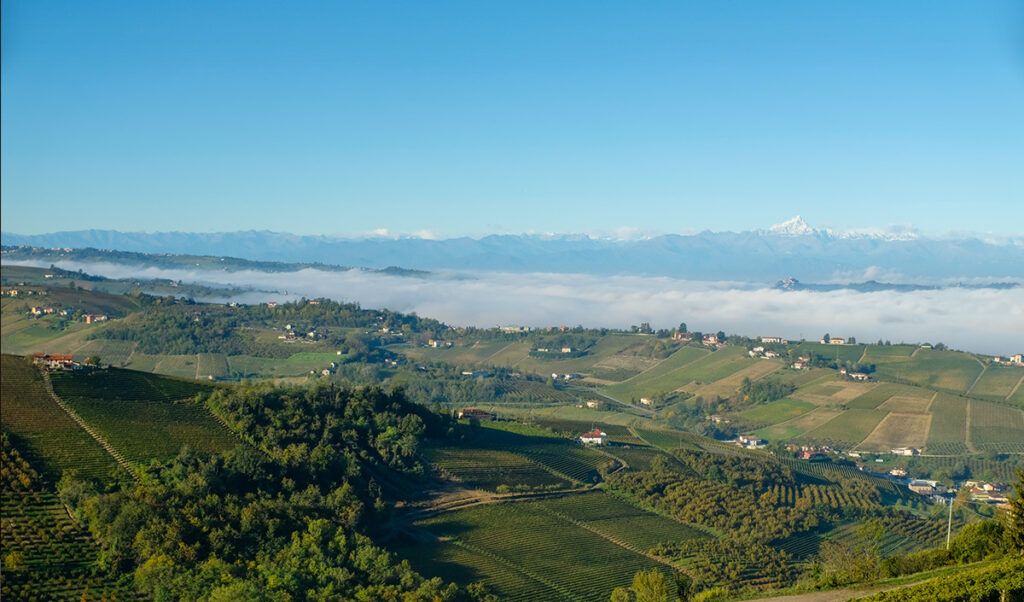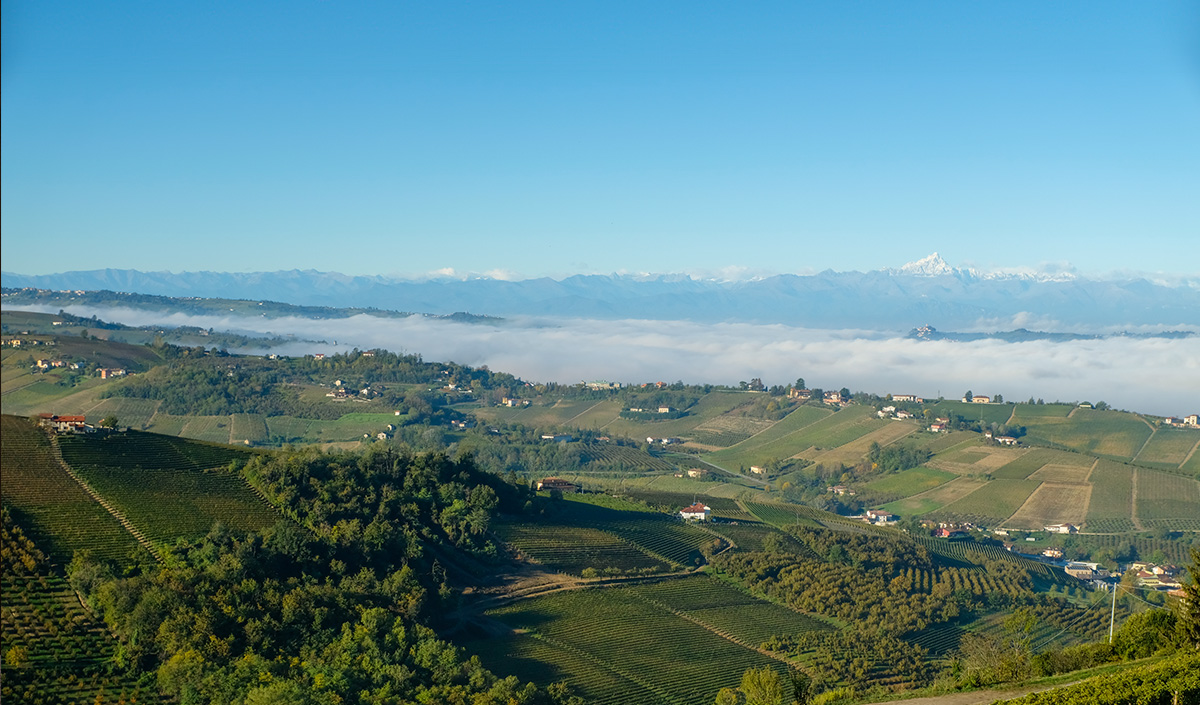Piedmont: in Search of the World’s Best Wines, Truffles and Hazelnuts
Quality-driven agriculture and a royal history have earned Piedmont a reputation as one of the best culinary destinations in the world.
Situated in the foothills of northwestern Italy’s Alps, Piedmont is a veritable gastronomic paradise. Its unique terroirs and indigenous grape varieties produce some of the world’s best wines. Its forests breed the famed white truffle and its prized Piedmont hazelnuts are cherished as a distinguished confectionery tradition. And old-school osterie and gourmet restaurants showcase a refined cuisine that is rooted in a distinct history. A Piedmontese culinary journey centres around the Vineyard Landscape of Piedmont, a UNESCO World Heritage Site that comprises five wine-growing areas extending over Langhe-Roero and Monferrato. Its gently rolling, vineyard-covered hillsides wrap around perched hilltop towns and are adorned with castles that once belonged to the royal House of Savoy.
Piedmont’s wine culture is characterized by small-scale family-run wineries that produce high-quality wines, often employing French winemaking techniques. Local grape varieties flourish in a perfect microclimate shaped by cool winds from the northern Alps and warm breezes from the Mediterranean Sea. Piedmont’s wines are a true expression of place, impossible to replicate anywhere else in the world. Here, it is the Nebbiolo grape that reigns supreme. Its name derives from nebbia, the Italian word for the characteristic fall fog that provides an additional layer of temperature mitigation and helps to produce more intense and balanced wines. Despite its small size and thin skin, Nebbiolo is a flavourful grape high in tannins and acidity, characteristics that allow its wines to be aged for decades. Its ultimate expression is in the robust and complex Barolo and Barbaresco wines. Two vineyards may grow the same grape yet deliver different results due to their unique soils and topographies; Barolo is bolder, Barbaresco brighter. Nebbiolo is increasingly sought-after by wine enthusiasts around the world.
The crown jewels of Piedmont’s cuisine are the white truffles that grow wild around the underground roots of hardwood trees in the forests surrounding Alba. Larger in size and with a more intense aroma than black truffles, they are a gourmet rarity only available from late September to the end of January each year. White truffles require a particular environment to grow, and thus cannot be cultivated anywhere else in the world. References to truffles date back to ancient times but by the 18th century, it was Piedmontese truffles that were the most desired by European courts, particularly the white truffles of Alba. A century later, it was the efforts of restaurateur and hotelier Giacomo Morra that brought white truffles to the rest of the world. He promoted them on his menus and gifted them to celebrities like Marilyn Monroe and Winston Churchill. White truffles sell for staggering amounts that continue to increase due to skyrocketing demand and environmental threats. Natale Romagnolo is a certified truffle judge with the National Truffle Board in Italy. “It is curious that people spend so much money on a mushroom that is composed of 85% water. The reason has to do with emotion. When you buy a white truffle, you are buying an emotion,” he shares. Natale explains that truffles are well-documented as aphrodisiacs, their aroma containing a natural chemical that stimulates emotion. The allure of white truffles brings visitors from around the world to Alba each fall. They also come for the opportunity to experience a truffle hunt with a professional truffle hunter who understands how to dig up a truffle without damaging it or its environment, to ensure its seasonal regeneration. Gian Piero Ottobrino comes from a family of truffle hunters. “It is our life. It is a passion that is hard to describe. We want that when people eat truffles in a restaurant, they understand the future sustainability of truffles, the life of the hunter and the relationship with the dog … we love our dog like part of the family. My dog and I have the same passion. She loves truffles just like me. When we are hunting, we are not working, we are playing … finding a truffle is exciting, it makes your heart beat.”
The forests of the Langhe also breed the IGP Piedmont hazelnut, recognized as the finest variety of hazelnut in the world. Hazelnut farmers adhere to strict methods that comply with the Indication of Geographic Protection certification of authenticity. At Altalanga Azienda Agricola, Gian Franco Cavallotto is dedicated to the biological cultivation of the IGP Piedmont hazelnut, also producing a range of exceptional hazelnut-based products at his state-of-the-art laboratory and shop in Alba. “The Piedmont hazelnut is not promoted. It is little-known in Europe, and not at all in the rest of the world. This is because the local hazelnut industry does not have large enterprises. We are an agricultural operation. Our objective is not to become big, it is to focus on quality,” he shares. Spherical in shape and with a delicate sweetness, the Piedmont hazelnut is particularly aromatic after roasting. Along with its ease of shelling and long shelf life, these characteristics differentiate it from other types of hazelnuts, and have helped shaped a prestigious confectionery industry. In the mid- 16th century, the House of Savoy brought South American cocoa beans from Spain to Turin, where master chocolatiers began to create chocolate confections. In the early 1800s, when Napoleon severed the trade link between Italy’s chocolatiers and South American cocoa beans, innovative chocolatiers turned to the abundant local hazelnuts, roasting them to release their aroma and grinding them into a fine powder that they mixed with their remaining cocoa. This blend, named gianduja, gave rise to a variety of confections, including confectioner Pietro Ferrero’s pasta gianduja, a sweet paste and precursor to Nutella.
The cuisine across all regions of Italy is ingredient-driven and characterised by simple preparations in the no-waste tradition of cucina povera, or “poor cooking.” However, Piedmont’s history as a kingdom that encompassed southeastern France also made a mark on its cuisine. Carlotta Panza is a food writer with a Master in Food Culture from the University of Gastronomic Sciences in Piedmont. She also designs gastronomic and enological experiences for Prior, a travel company that curates unique story-telling travel experiences around the world. “Piedmontese cuisine differentiates itself not just for its high-quality ingredients, but for the approach to courses of a meal. For example, in most parts of Italy, antipasti are small, simple preparations, but in Piedmont they are thought-out, sometimes intricate dishes with a noteworthy history that carry the same importance as other courses of a meal. This is because most Piedmontese dishes underwent a transformation when they were adapted to please the House of Savoy. This also explains why the influence of French cuisine is palpable in Piedmont’s traditional antipasti.” Piedmont’s tastemakers are invested in preserving quality-driven small-scale agriculture that delivers intensely flavourful products including wines, white truffles and hazelnuts. Piedmont’s gastronomy is further distinguished by its royal history, which brought refinement and technique to the region’s culinary practices and traditions and helped earn it a reputation as one of the best culinary destinations in the world.
























































































